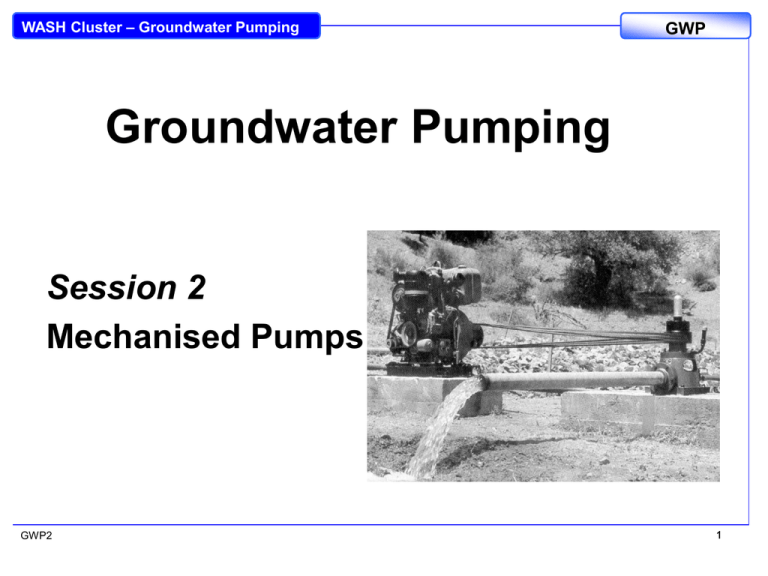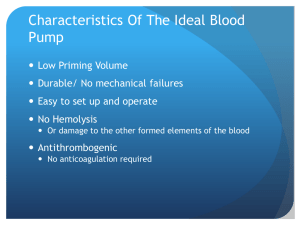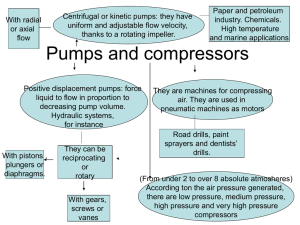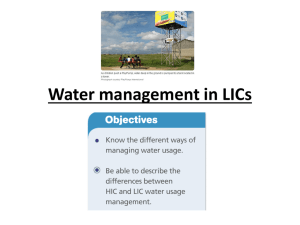GWP2_PP_Motorised Pumps
advertisement

WASH Cluster – Groundwater Pumping GWP Groundwater Pumping Session 2 Mechanised Pumps GWP2 1 WASH Cluster – Groundwater Pumping GWP Pump classification Positive displacement Rotodynamic Centrifugal Axial flow Submersible Surface mounted Positive rotary e.g helical rotor Reciprocating WASH Cluster – Groundwater Pumping GWP Power sources They may be driven by: – – – – – GWP2 Electricity from the national grid, Diesel engine for direct drive Diesel engine for electricity generation Photovoltaic system Wind-powered pumps 3 WASH Cluster – Groundwater Pumping GWP Motorised Pumps Pumps are machines designed to add energy to fluids. They typically do this by using a rotating element to push a fluid in one direction. Rotodynamic pumps generate flow by using one of three actions: radial flow, mixed flow, and axial flow. These classifications do not rate the performance quality of the pump, they are merely groupings based upon the pump’s action. GWP2 4 WASH Cluster – Groundwater Pumping GWP Motorised Pumps (Radial Flow) GWP2 Radial flow pumps are centrifugal pumps in which the pressure is developed wholly by centrifugal force. Radial flow pumps consist a rotating impeller and stationary casing (volute or solid). The impeller produces liquid velocity and the casing forces the liquid to discharge from the pump converting velocity to pressure. Centrifugal pumps to produce continuous flows at high pressure. 5 WASH Cluster – Groundwater Pumping GWP Motorised Pumps (Axial Flow) In mixed flow pumps, the pressure is developed partly by centrifugal force and partly by the lift of the vanes of the impeller on the liquid. Axial flow centrifugal pumps develop pressure by the propelling or lifting action of the vanes of the impeller on the liquid. An axial flow essentially consists of a propeller in a pipe. The propeller can be driven directly by a sealed motor in the pipe or mounted to the pipe from the outside by a drive shaft that pierces the pipe. GWP2 6 WASH Cluster – Groundwater Pumping GWP Submersible Pumps Centrifugal Pumps are rotodynamic pumps, which convert mechanical energy into hydraulic energy by centripetal force on the liquid. A rotating impeller increases the velocity of the fluid. The vanes in the casing of the pump then convert this amplified velocity into a rise in pressure. The pumps usually have multiple impellers. The selection of the correct size of the pump for its intended duty point is important. Energy is wasted if the pumps are operated far away from the optimal running point. GWP2 7 WASH Cluster – Groundwater Pumping GWP Submersible Pumps The main parts of a submersible pump are: Electric motor hermetically enclosed in a stainless steel sleeve, Pump body either a centrifugal pump or a positive displacement pump Rising main of GI or stainless steel pipes connected with sockets or PVC-HI hose. If a hose is used, the motor with connected pump body has to be hung from the top of the well by a stainless steel cable, Electrical cable for connecting the motor to the starting panel (power source), Starting panel Various sizes of submersible pumps are available, which can be installed in casings of Ø3”, 4”, 6”, 8”, 10” and 12”. GWP2 8 WASH Cluster – Groundwater Pumping GWP Positive displacement pump Progressive cavity pumps • Water moves by trapping a fixed amount of fluid and forcing that trapped volume into the discharge pipe. • Pump is a single helix rotor inserted into a double helix stator. • This forms pockets of water which are lifted from the bottom to the top • Produces a constant flow • Small diameter pumps for boreholes are considerably more efficient than centrifugal pumps. • Progressive cavity pumps have high starting torque which is important if using solar systems GWP2 9 WASH Cluster – Groundwater Pumping GWP AC mains power Mains electricity is normally supplied as single phase current at either 220 Volt and 50 Hz frequency (Europe, Africa, Asia) or at 110V and 60Hz (America). For high power connections over 10KW nearly always 3-phase power is supplied at a voltage of 380V. Electric motors are generally available from the smallest size of 100-200W. They run on a fixed speed depending on the frequency (1500rpm at 50 Hz or 1800rpm at 60Hz). Energy efficiency is between 75% for small motors to 90% for bigger size motors. Long distances from grid to the pump site require high investment in the power line. GWP2 10 WASH Cluster – Groundwater Pumping GWP Internal combustion engines GWP2 Petrol engines are less common because the highly flammable fuel is difficult to handle and they are not as reliable and efficient as diesel. Diesel engines for stationary applications run at about 1,200 to 1,400 rpm and their efficiency is about 30% (i.e. the fuel consumption is about 200300 g/kWh or 0.25 – 0.4 lt/kWh). Engines require regular maintenance, which necessitates often a full-time operator. And the logistics to ensure that enough fuel and lubricants are always available need to be sorted out. Diesel fuel is more expensive than electricity from the grid. Diesel generators are used in places without connection to the power grid or as emergency power-supply if the grid fails. These generators are widely used for not only emergency power, but also many have a secondary function for providing back up power to utility grids. Diesel Generator (Skat) Petrol Generator (Briggs and Strat 11 WASH Cluster – Groundwater Pumping GWP Pump selection to meet demand When water is pumped to a higher elevation the pumping effort is the total head plus the friction head loss in the pipeline. The friction head loss for a given flow rate can be calculated for any chosen pipe diameter. Smaller pipes create higher losses than bigger pipes because the water speed is greater. The pump has to be chosen that is able to produce the required flow and pressure. The daily water demand in a community area will vary during the year due to seasonal pattern of the climate, the work situation, cultural or religious occasions 12 WASH Cluster – Groundwater Pumping GWP Pump power Pw = Qρgh Where: Pw= Water power Q = flow rate of water (m3/s) ρ= density of water (≈1000kg/m3) g = 9.8m/s2 h = operating pressure head Required input power = Pw/η Where η = overall efficiency WASH Cluster – Groundwater Pumping GWP Sizing a pump 1. Draw system curve for range of flows, including the required flow (use table given as handout) 2. Select a pump which matches the duty required and obtain the characteristic curves 3. Superimpose the two curves to find the operating point 4. Check it gives you the required flow rate WASH Cluster – Groundwater Pumping GWP Adjusting your pump Ideally the operating pump will correspond as closely as possible to the required flow rate. Otherwise you can alter the speed of the pump to achieve this but: Flow – varies with speed Head – varies with (speed)2 Power – varies with (speed)3 So varying the speed will greatly increase the power demand. WASH Cluster – Groundwater Pumping GWP • Appendix 1 – Solar powered pump sizing WASH Cluster – Groundwater Pumping GWP Sphere standards: max 500 people/handpump – assume need to use max Daily necessary is 15 l/person and say head is 30m. Step Calculate the peak daily hydraulic output (in kWh) Formula Ehyd = QxH/367 Example Number of people = 800 Ehyd = peak daily hydraulic energy output (kWh/d) Daily demand = 40l/cap Q = output required (m3/d) H = total pumped head (m) Estimate the subsystem η = the efficiency of conversion of efficiency = η electricity to hydraulic output (wire-towater). Consult the manufacturer's documentation or technical studies. Head = 27 m Q = 800x0.04 = 32 m3/d Ehyd = 32x27/367= 2.35 kWh/d η = 0.5 Good: 50-70% - Bad: 20-30% Calculate the daily l energy demand GWP2 Ehyd eff = Ehyd/η Ehyd eff = 2.35/0.5 = 4.71 kWh/d 17 WASH Cluster – Groundwater Pumping Calculate the daily irradiation per square metre Look up the mean extra-terrestrial radiation in the map above for the location, given on the map, and finally reduce by a 20% margin of safety (safety factor = 0.8) Edaily/m2 = Irrrad x Safety factor GWP Location = Ethiopia Latitude = 15o Irradiation: ~5.5 kWh/m2 Edaily/m2 = 5.5 x 0.8 = 4.4kWh/m2 Calculate approximate peak watt rating Ppeak = Ehyd eff/Edaily/m2 x1,000W/m2 Calculate the number of modules Choose a module (Wp per unit) Module: Wp = 55 Wp/unit Modules = Ppeak / Wp (round up the answer to an integer number) No’s = 1,070 / 55 = 19.46 Panel : $500 each (x20) Pump: $1,000 Total = $11,000 without tank Cost (approximate) GWP2 Ppeak = 4.71 / 4.4 x1,000 = 1,070 Wp Round Up No’s = 20 18 WASH Cluster – Groundwater Pumping Solar GWP • One slide explaining PVs • A photovoltaic module is a packaged interconnected assembly of photovoltaic cells, also known as solar cells. Current is created when light falls onto the active surface. • mono-crystalline silicon, multi-crystalline silicon, and amorphous silicon. New, non-silicon types such as cadmium telluride (CdTe) and Copper Indium Disellenide (CIS) have recently become available too. GWP2 19 WASH Cluster – Groundwater Pumping GWP2 Solar GWP 20 WASH Cluster – Groundwater Pumping GWP Sizing Photovoltaic System The mean daily water demand and the mean daily solar irradiation during the least sunny month need to be determined as the starting point for sizing a solar pump. The diagram provides a quick indication of power requirements. It should be noted that the result is only an estimate and the graph should not be used for final sizing of the system Session Name here GWP2 21 WASH Cluster – Groundwater Pumping GWP Simplified method for sizing GWP2 Fraenkel and Thake give a simplified method of calculating the size of a solar system in their book Water Lifting Devices. The method provided here is an adaptation of their method that facilitates a ‘rough and ready’ calculation of the solar array. Sources such as the World Meteorological Organization publish irradiation figures for the whole world. Maps that cover large areas or whole regions can be used to make a reasonably accurate judgement of the irradiation for a particular location. Peter Fraenkel and Jeremy Thake, Water Lifting Devices: A Handbook for Users and Choosers (Food and Agriculture Organization, 2006). 22 WASH Cluster – Groundwater Pumping GWP2 GWP 23 WASH Cluster – Groundwater Pumping GWP To get a fairly accurate idea of the size and cost of a photovoltaic array it is necessary to know at least the following parameters: Water consumption per capita per day Total no. of households Persons per household Total population Yield of water source (m3/day) Distance to source Distance from source to tank Static water table Expected dynamic water table Elevation from source to tank Total pumping head GWP2 24 WASH Cluster – Groundwater Pumping • Appendix 2 – Other types of motorised pump GWP WASH Cluster – Groundwater Pumping GWP Motorised Pumps GWP2 There are three main types of motorised pumps that are suitable to be installed in boreholes: Submersible Pumps Line Shaft Pumps Jet Pumps The standard power sources possible for the three pump types mentioned above are: Electric AC mains Diesel engines Petrol engines her. Solar powered Pumps Wind powered Pumps 26 WASH Cluster – Groundwater Pumping GWP Line Shaft Pumps GWP2 Line Shaft Pumps have the driving element (motor) above ground; and the pumping element is at the bottom of the well. A “Line Shaft” is used to connect the motor with the pumping element. The speed of the motor is directly applied to the pumping element by the line shaft. Gearboxes or V-belt drives might be used for adjusting the speed. Various motor types can be used to drive the pumping element (diesel engine, petrol engine, electric motor etc.). The pumping element can vary too, but mostly used are: Vertical turbine pumps similar to the submersible pumps, Positive displacement unit, progressive cavity pumps (Mono). 27 WASH Cluster – Groundwater Pumping GWP Jet Pumps A Jet Pump is an impeller-diffuser pump. About half of the drawn water is split in the diffuser and sent back to the well with high pressure through the pressure pipe. At the end of the pressure pipe, the water is accelerated through the cone shaped nozzle and guided through the mixing chamber with high speed. A pressure drop in the mixing chamber sucks in water from the ejector body and intake. The water goes up the return pipe and through the impeller into the diffuser, where one part is sent back to the jet nozzle and the other part is directed into the delivery pipe. Jet Pumps are relatively inefficient but can tolerate a wide range of operating conditions, including abrasive fluids such as water with high sand contents. GWP2 28




